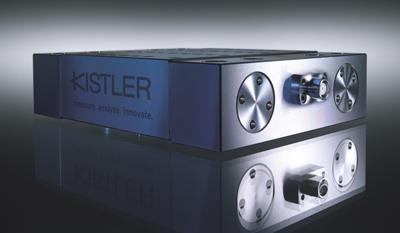
Kistler is adding a new member to its family of horizontally pretensioned stationary dynamometers: the Type 9139AA dynamometer. This instrument measures forces in the cutting process with outstandingly high signal quality, so it opens up various possibilities: accurate analysis of cutting processes or machining strategies, and optimization of auxiliary equipment such as cutting tools. The successor model to Type 9265B features a compact and extremely rugged structural design as well as a wide measuring range of 30 kN in all three directions. Even at high spindle speeds, the dynamometer's high natural frequency allows accurate analysis of the cutting process.
The patented design with horizontal pretensioning largely eliminates the negative impact of heat that is typically generated during the cutting process, so signal drift is minimized. The wide force range reportedly makes the Type 9139AA ideal for high-performance cutting.
Type 9139AA is used for accurate analysis of highly dynamic cutting processes. High-precision measurements of all forces occurring provide a sound basis for users to optimize cutting processes, machining strategies, cutting tools and auxiliary equipment, such as coolants. Of course, Kistler's latest dynamometer is also suitable for verifying simulations. Type 9139AA is specifically designed for milling applications and flat grinding with high removal rates and correspondingly high forces. But this dynamometer can also be used for drilling, other cutting applications and force measurements in general. The Type 9139AA dynamometer will replace the existing Type 9265B.
Following on from Types 9129AA and 9119AA, Type 9139AA is the third stationary dynamometer in Kistler's family of horizontally pretensioned dynamometers. This model features a compact design and a wide measuring range of 30 kN in all three directions.
Natural frequency was a key issue in Kistler's development work on the Type 9139AA. Extensive FEM analyses were carried out to optimize the design and structure so that natural frequencies of about 3 kHz are achieved despite the dynamometer's size. This minimizes negative dynamic impact on the measurement signals, so cutting processes are captured accurately even at high tooth passing frequencies.
The thermal energy generated during the cutting process usually causes undesirable signal drift. Kistler's Type 9139AA, 9129AA and 9119AA dynamometers feature a patented design with horizontal pretensioning that largely eliminates these negative influences. The result: even processes that generate large amounts of heat or those with thermal differences can be captured accurately.
The large number of threaded holes make it simple to mount workpieces on the Type 9139AA. Mounting the dynamometer on the machine table is equally straightforward. The Type 9139AA dynamometer is based on the Fischer flange connector concept that is in widespread use, with the same pin assignment as all Kistler's other stationary dynamometers. It is easy to replace the measuring platform, and the existing cables and charge amplifiers can be used again.
Contact Details
Related Glossary Terms
- dynamometer
dynamometer
When drilling, a device for measuring the generated torque and axial force (thrust). When milling, a device for measuring the generated torque and feed force. When turning, a device for measuring the tangential, feed and radial forces.
- flat ( screw flat)
flat ( screw flat)
Flat surface machined into the shank of a cutting tool for enhanced holding of the tool.
- gang cutting ( milling)
gang cutting ( milling)
Machining with several cutters mounted on a single arbor, generally for simultaneous cutting.
- grinding
grinding
Machining operation in which material is removed from the workpiece by a powered abrasive wheel, stone, belt, paste, sheet, compound, slurry, etc. Takes various forms: surface grinding (creates flat and/or squared surfaces); cylindrical grinding (for external cylindrical and tapered shapes, fillets, undercuts, etc.); centerless grinding; chamfering; thread and form grinding; tool and cutter grinding; offhand grinding; lapping and polishing (grinding with extremely fine grits to create ultrasmooth surfaces); honing; and disc grinding.
- milling
milling
Machining operation in which metal or other material is removed by applying power to a rotating cutter. In vertical milling, the cutting tool is mounted vertically on the spindle. In horizontal milling, the cutting tool is mounted horizontally, either directly on the spindle or on an arbor. Horizontal milling is further broken down into conventional milling, where the cutter rotates opposite the direction of feed, or “up” into the workpiece; and climb milling, where the cutter rotates in the direction of feed, or “down” into the workpiece. Milling operations include plane or surface milling, endmilling, facemilling, angle milling, form milling and profiling.
